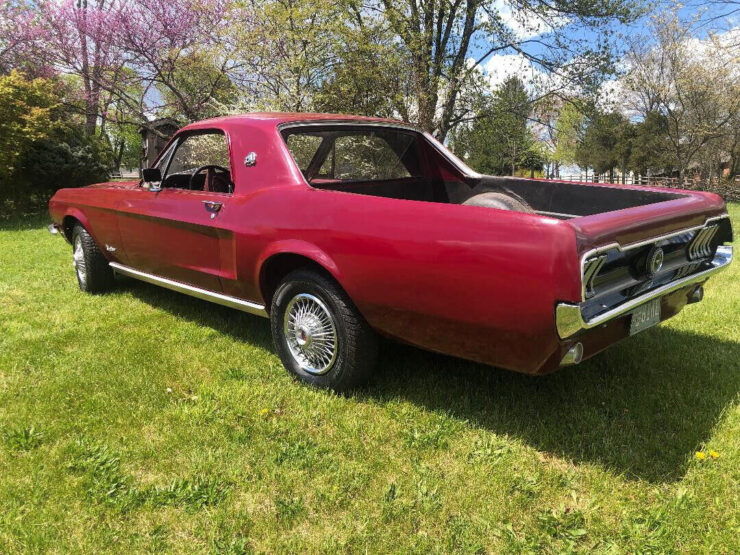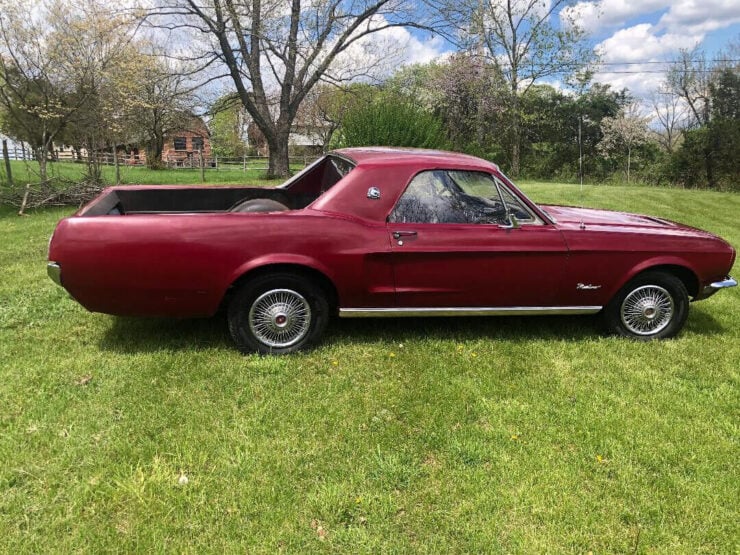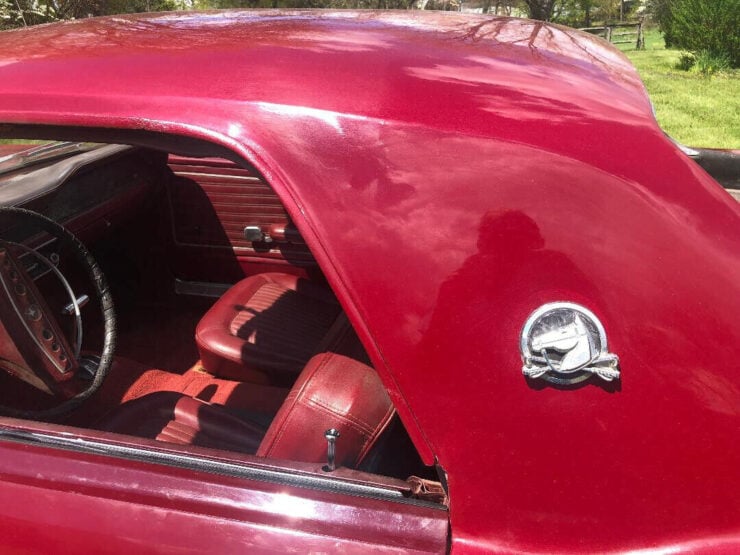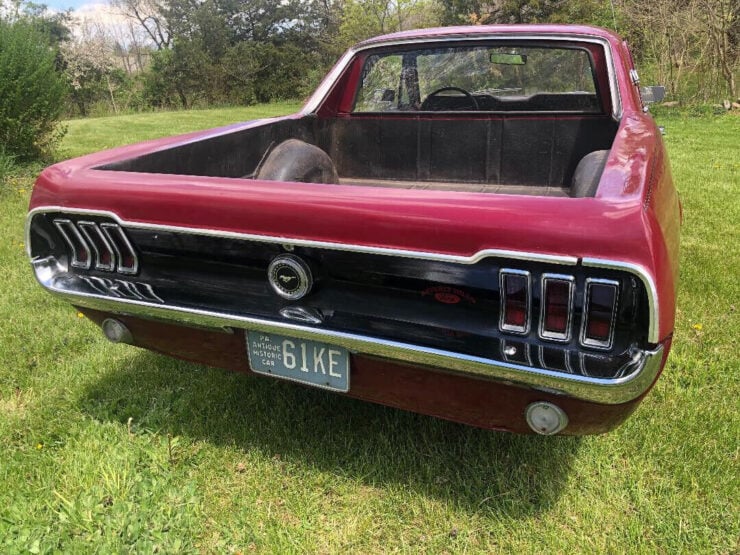This is a recreation of the rare Ford Mustang Mustero, a custom vehicle that was sanctioned by Ford as a pickup version of its wildly popular Mustang pony car. Just 50 are said to have been made, and far fewer have survived to the current day.
The Mustang Mustero was built by Beverly Hills Ford, a Los Angeles dealership, with a shortened roofline and a pickup bed rear. It was called the “Mustero” as a reference to the Mustang and the earlier Ranchero – Ford’s original ute-style pickup.
Fast Facts – The Ford Mustang Mustero
- In the mid-1960s, Beverly Hills Ford in Los Angeles developed the Ford Mustang Mustero, seeing a gap in Ford’s lineup for a utility pickup sports car. They managed to get official approval from Ford corporate, allowing them to proceed with the project.
- The idea was influenced by the Ford Ranchero, an automobile-based utility pickup that was moderately successful from its debut in 1957 through its discontinuation in 1979. The Ranchero had evolved over its lifespan from a utilitarian vehicle to one offering more luxury and higher performance, which likely inspired the notion of this Mustang-based utility vehicle.
- The Mustang and the second-generation Ranchero shared the Ford Falcon platform. This shared foundation likely facilitated the development of the Mustero, combining the practicality of a pickup with the sporting pony car essence of the Mustang.
- The Mustang Mustero conversion was intricate and costly, involving significant structural changes like relocating pillars and removing rear seats to accommodate the pickup bed. Despite official backing and a planned production of 50 units starting in 1966, the high cost and specific niche appeal seem to have limited its popularity.
How The Ford Mustang Mustero Came To Be
In the mid-1960s a plan was hatched at Beverly Hills Ford, an LA Ford dealer and custom workshop, to create a car they felt was missing from the Ford official line up. This new car would be a Mustang pickup, a ute as the Australians would call it, and amazingly they managed to get full official approval from Ford corporate for the project.


Ford had entered the automobile-based utility pickup market previously, with the Ford Ranchero production vehicle that debuted in 1957 based on the newly introduced full-sized Ford platform. The Ranchero would never be a major sales hit for Ford, but the numbers were good enough to keep it in production over seven generations until 1979.
Initially the Ranchero had been relatively utilitarian, but as new generations were introduced it became more luxurious, and higher-performance versions were released – all of which are highly collectible today.
The second generation Ranchero was based on the Ford Falcon platform, as was the Mustang of the same era, and it seems to have been this shared platform that sparked the idea at Beverly Hills Ford to create a new kind of Ford pickup – with all the practicality of the pickup bed in the rear, as well as the Mustang’s sports car DNA.
Officially sanctioned special editions of the Mustang were nothing new by this point in the mid-1960s, Carroll Shelby already had his Shelby GT350 in production, and it had quickly become one of the most desirable cars of its time in the country.
Perhaps inspired by this, a project to build 50 Ford Mustang Musteros was undertaken, with production getting underway in 1966. The Mustero build process was complex and costly, requiring far more major changes to the car than the Shelby Mustangs of the same era. The Mustero had the rear section of its roof removed, the C-pillar was moved forward to replace the B-pillar, and the newly shrunk cabin had the rear seats removed to make way for the pickup bed.
The rear end of the Mustang remained in place with the taillights and bumper, which meant that no fold-down tailgate was possible. This does make loading and unloading the bed a little more challenging than a standard pickup, as loads have to go in over the sides or rear.
When ordering a new Mustero from Beverly Hills Ford you could choose the color you wanted, as well as either the 200 cubic inch (3.3 liter) Thriftpower inline six or the considerably more powerful 289 cubic inch n(4.7 liter) Windsor V8. Additionally, you could choose from the 3-speed automatic or 4-speed manual transmissions.


There’s no record of whether additional suspension work was done to the Mustero, it would make sense that the rear leaf springs would be swapped out with stiffer replacements to better carry loads, but we’ve been unable to confirm if this took place.
The popularity of the Mustero was somewhat limited, likely due to the price of $6,500 USD in 1966 dollars. This is the equivalent to $62,659 USD in 2024 currency, which made the Mustero more expensive than a Shelby GT350 and only $500 less than a new Lamborghini Miura.
The exact number produced is generally cited at 50 units, though there has been some suggestion that fewer than this were made, and that 35 ended up in Europe and at least two somehow made their way to Australia. Production ran for a single year between 1966 and 1967.
How many have survived to the current day is openly debated, there seem to be at least 12 original examples, but there are likely more in barns, sheds, and garages in various states of disrepair.
The 1968 Mustang Mustero Recreation Shown Here
The vehicle you see here is currently being offered for sale on eBay out of Perkasie, Pennsylvania with a Buy It Now price of $18,000 USD. This is far less than the typical asking price of a Mustero as this car is not one of the Beverly Hills Ford originals, but rather it’s a recreation based on a 1968 Mustang.
The story behind its creation is included below from the eBay listing:
“Fifteen years ago, my daughter and I took this tribute Mustero on as a “father-daughter” bonding project. It had been used on and off over the years (including in her wedding), and has been in the garage 99% of the time, but now is the time for it to move this vehicle to have a lucky new owner.”


“I’ve done many Mustang projects over the years, professionally, and as a hobbyist, including having a Mustang in Hot Rod Magazine (August 1979), so rest assured this is not a hack job. The bed metalwork is totally professional, and it is coated with the expensive rubberized bed liner. The hood is the highly desired turn signal type, The vehicle started out as a solid car throughout, and if there is any rust it will be very minor.”
If you’d like to read more about this car or make him an offer you can visit the eBay listing here.










Images courtesy of eBay Motors








